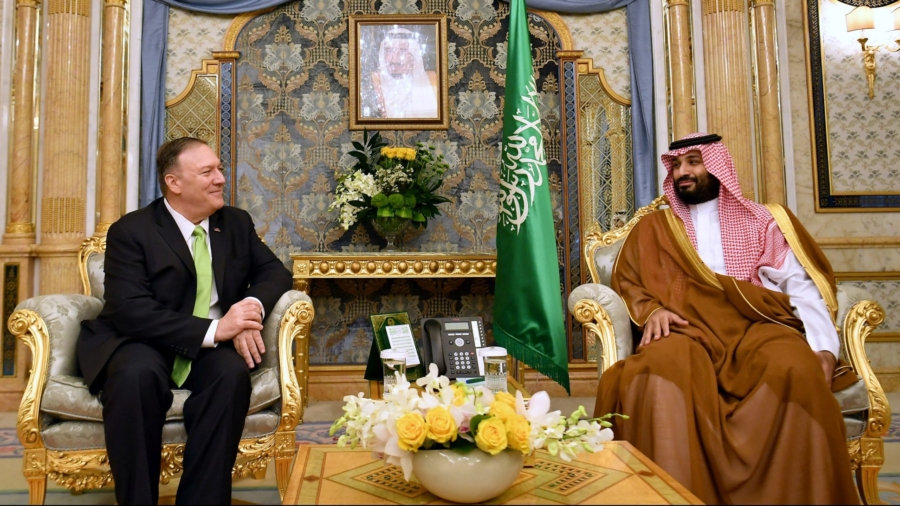The United States said on Sept. 19 that it was building a coalition to deter Iranian threats following an attack on Saudi Arabian oil facilities over the weekend.
U.S. Secretary of State Mike Pompeo said that Trump, who has ordered more sanctions on Iran, wants a peaceful solution to the crisis.
He was speaking after talks with Saudi and Emirati leaders over the strike that Washington and Riyadh have blamed on Tehran.
Iran denies involvement in the Sept. 14 attack that initially halved Saudi oil output and which Pompeo earlier called an “act of war” against the world’s largest oil exporter.
Iran has warned U.S. President Donald Trump against being dragged into a war in the Middle East and said it would meet any offensive action with a crushing response.
Pompeo appeared to soften his tone on Thursday after talks with Abu Dhabi’s crown prince, the de facto ruler of the United Arab Emirates, which is Riyadh’s main Arab ally.
“We are here to build out a coalition aimed at achieving peace and a peaceful resolution. That’s my mission, that’s what President Trump certainly wants me to work to achieve and I hope that the Islamic Republic of Iran sees it that way,” Pompeo told reporters.
He did not provide details about the coalition. The United States has however been trying to create a global maritime security alliance since attacks on oil tankers in Gulf waters, for which Washington says Iran was responsible.
UAE, Saudi Arabia, Britain, and Bahrain have said they will participate. Iraq said it would not join, and most European countries have been reluctant to sign up.
Saudi Displays Evidence
On Wednesday, the Saudi military displayed what it said is an Iranian cruise missile and drones used in the attacks on its oil facilities at Abqaiq and Khurais.
“The attack was launched from the north and was unquestionably sponsored by Iran,” Saudi military spokesman Col. Turki al-Malki told journalists in a press conference, according to the Associated Press.
The news conference took place with a backdrop of broken and burnt drones and pieces of one cruise missile allegedly collected from the attacks.

Eighteen drones and seven cruise missiles were launched in the assault, Al-Malki said, with three missiles failing to make their targets. He said the cruise missiles had a range of 435 miles, meaning they could not have been fired from inside Yemen. He played surveillance video he said showed a drone coming in from the north. Satellite images released earlier by the U.S. showed damage mainly on the north-facing sides of structures at the sites.
“The Kingdom condemns this egregious crime, which threatens international peace and security, and affirms that the primary target of this attack are global energy supplies, as this attack is in line with the previous attacks against Saudi Aramco pumping stations using Iranian weapons,” said the Saudi Ministry of Foreign Affairs in the statement.
It said it’ll invite the United Nation’s experts and other international experts to check the existing situation and to participate in the investigation.
Trump’s Options
Full-blown military strikes against Iran would have to be robust enough to “severely diminish Iran’s military capabilities,” according to Rick Fisher, senior fellow on Asian Military Affairs at the International Assessment and Strategy Center, a Virginia-based think tank. But he acknowledged that Iran is “well practiced” at hiding missiles underground.
“Depending on how good our intelligence is, we may not be able to prevent a sizable Iranian secondary strike,” he said.
Trump has multiple options to retaliate against Iran in a more measured manner.
The United States can, for instance, enforce a Navy blockade to stop Iran’s oil exports, said Peter Huessy, director for Strategic Deterrent Studies at the Mitchell Institute for Aerospace Studies.
The United States can also “find mullahs’ overseas cash and assets and seize such Iranian individual and national assets, as payment for previous Iranian terrorism harm,” he said.
In addition, the United States has a broad set of surreptitious means of war, including cyberweapons and special operations.
Trump established the U.S. Cyber Command last year to, among other things, “create very, very severe and powerful offensive threats, should we need them,” he recently said at the White House.
Cyber attacks can be used to shut down Iran’s refinery capacity, other areas of its economy, or even its electric power grid, Huessy said.
Special operations forces, meanwhile, are trained in sabotage and psychological operations.
Epoch Times reporter Venus Upadhayaya and Petr Svab, Reuters and The Associated Press contributed to this report.

